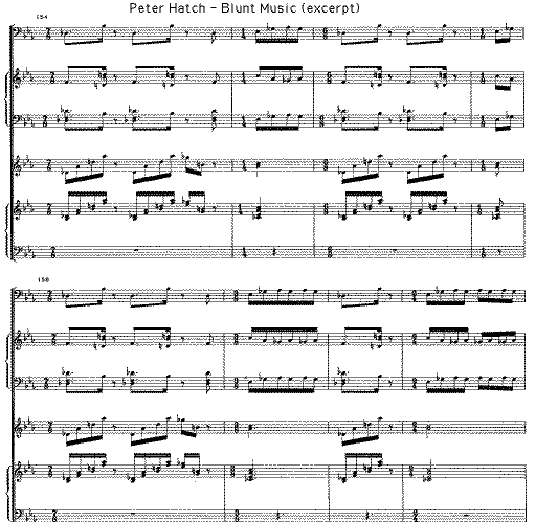Mildred's Thoughts
Music by Peter Hatch (Texts by Gertrude Stein)
Performed by NUMUS. Catalog: ART-011
The story so far...
by Christopher Fox
For the last fifteen years Canadian Composer Peter Hatch has been steadily generating a remarkable body of work, remarkable not only because its good to listen to but also because it's capable of stimulating our intelligence as well as our ears. This is the first disc to be devoted exclusively to this music.
Two things become clear about Peter Hatch from this disc: one is his delight in the very stuff of music, the pleasure he finds, and wants us to share, in listening to sounds rubbing together, or stretching out, or bouncing off one another; the other is his fascination with the words and ideas of Gertrude Stein. Of the five works recorded here, three are specifically connected with Stein: in A Chopsticks Fantasy and Reflections on the Atomic Bomb, texts by Stein are spoken during the music (something Hatch does elsewhere in his When Do They is not the same as Why Do They [1988], one of the most striking recent additions to the solo percussionist's repertoire); in And As He Stein's words are sung. And As He is the middle movement from Hatch's largest work to date, Mounting Picasso (1993), which projects Stein's "If I told him: A Completed Portrait of Picasso" into an evening-long piece of music-theatre.
It's hard to think of a composer (certainly not since John Cage in the 1940s) on whom the writing of Gertrude Stein has had such a profound influence. But Hatch's work was Stein-ish even before it began to make specific reference to her; indeed if Gertrude Stein hadn't existed Peter Hatch would probably have had to invent her eventually.
Blunt Music is an example of Hatch's pre-Stein Stein-ish-ness. In the north of England (my home), the expression 'to put it bluntly' is not so much an apology for a lack of verbal precision as a promise that what is to be said will be said clearly, without affectation. This it seems to me is part of what all Peter Hatch's work (and not just Blunt Music) is about. Hatch is not afraid to appropriate musical figures and forms with which we are already familiar, like the simple tonal harmonies which form the materials of Blunt Music or the folk-clarinet figures ofEurhythmy. What Hatch recognises is that the very familiarity of these sounds breeds the ambiguities on which his music thrives. Again there's a debt to Stein; as in her work the words may be simple, but combined they form complex ideas. Or as she said herself, 'sentences are not emotional and paragraphs are;' in Stein and Hatch's art expression lies not in the formation of bon mot but in the twisting and turning of gathered evidence.
What are the notes F and G when they're sounded together on a piano? Sometimes they're the sound of a piano, sometimes they're a major second, sometimes they're the first two notes of the third inversion of a dominant seventh chord in root position, and sometimes they're the beginning of Chopsticks. In A Chopsticks Fantasy Peter Hatch makes his music in this space between the signifier and the signified and the result is both exciting and witty. (I particularly like the moment where the piano idiom veers sharply towards avant-gardiste chaos, the sort of piano writing of which conservative listeners say, 'A three year old could do better' -- But three year olds like to play Chopsticks too!)
The moment when things turn out not to have been what we thought they were is a moment that Peter Hatch is fond of visiting. On this disc there are at least three examples, none more spine-tingling than that at the end of Reflections on the Atomic Bomb when Stein's chillingly acute observations, not so much about the atomic bomb as about humanity's capacity for disinterest (if it's not The Bomb then it's Bosnia, if it's not Bosnia then it's a bomb in a building full of children) are spoken over music whose components we thought we knew. Until this coda begins , we believe that we are listening to a beautifully crafted piece of ensemble music. There is much to enjoy: the unfolding of long-legged melodic lines, subtly graded harmonies and a sophisticated two movement form which nests disruptive elements of each movement in the heart of the other movement. None of this prepares us for the sting in the tail, but that story is best told by the music itself...
Christopher Fox is a composer/writer who lives in York, England.
�1995 Christopher Fox
About Me —





Blunt Music
1986 • 13 minutes • Two marimbas, two pianos
Blunt Music was completed in April of 1986. The title refers to the 'bluntness' of the main body of the work - a constant, loud, driving rhythmic force from beginning to end.
After a short introduction in which the pitch material of the work is introduced (it hovers between dominant seventh chords on E and Bb) the bulk of the work is concerned with various rhythmic cells which repeat a fair number of times but never in an exact fashion. The desired effect is of constant expectations of rhythm (especially metric rhythm) being met, but also constantly displaced, leaving the listener 'on edge', as with a march in which the steps get mixed up.
Blunt Music was premiered by The New Art Quartet in 1988.

